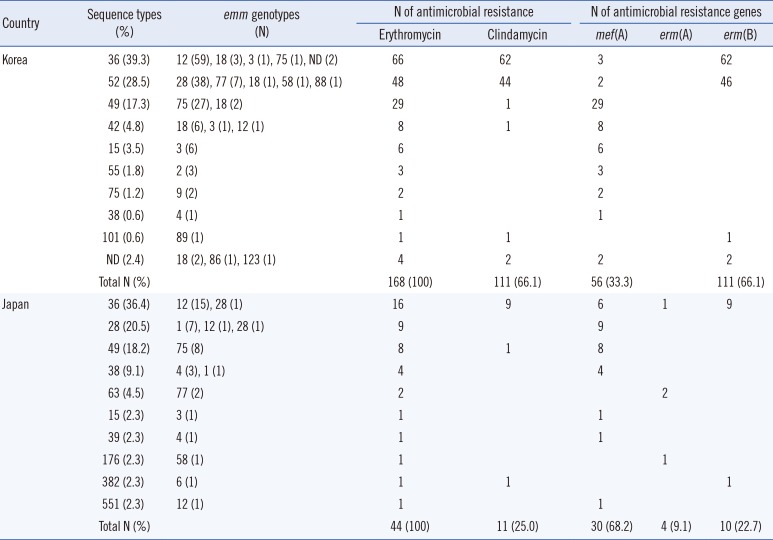1. Cunningham MW. Pathogenesis of group A streptococcal infections and their sequelae. Adv Exp Med Biol. 2008; 609:29–42. PMID:
18193655.
2. Takahashi T, Sunaoshi K, Sunakawa K, Fujishima S, Watanabe H, Ubukata K. Clinical aspects of invasive infections with
Streptococcus dysgalactiae ssp. equisimilis in Japan: differences with respect to
Streptococcus pyogenes and
Streptococcus agalactiae infections. Clin Microbiol Infect. 2010; 16:1097–1103. PMID:
19732082.
3. Cha S, Lee H, Lee K, Hwang K, Bae S, Lee Y. The emergence of erythromycin-resistant
Streptococcus pyogenes in Seoul, Korea. J Infect Chemother. 2001; 7:81–86. PMID:
11455497.
4. Kim S, Lee NY. Antibiotic resistance and genotypic characteristics of group A streptococci associated with acute pharyngitis in Korea. Microb Drug Resist. 2004; 10:300–305. PMID:
15650374.
5. Koh E, Kim S. Decline in erythromycin resistance in group A Streptococci from acute pharyngitis due to changes in the
emm genotypes rather than restriction of antibiotic use. Korean J Lab Med. 2010; 30:485–490. PMID:
20890080.
6. Enright MC, Spratt BG, Kalia A, Cross JH, Bessen DE. Multilocus sequence typing of
Streptococcus pyogenes and the relationships between
emm type and clone. Infect Immun. 2001; 69:2416–2427. PMID:
11254602.
7. Wajima T, Chiba N, Morozumi M, Shouji M, Sunaoshi K, Sugita K, et al. Prevalence of macrolide resistance among group A streptococci isolated from pharyngotonsillitis. Microb Drug Resist. 2014; 20:431–435. PMID:
24571416.
8. Clinical and Laboratory Standards Institute. Performance standards for antimicrobial susceptibility testing. Twenty-second Informational supplement, M100-S23. Wayne, PA: Clinical and Laboratory Standards Institute;2013.
9. Arai K, Hirakata Y, Yano H, Kanamori H, Endo S, Hirotani A, et al. Emergence of fluoroquinolone-resistant
Streptococcus pyogenes in Japan by a point mutation leading to a new amino acid substitution. J Antimicrob Chemother. 2011; 66:494–498. PMID:
21172783.
10. Reinert RR, Lütticken R, Bryskier A, Al-Lahham A. Macrolide-resistant
Streptococcus pneumoniae and
Streptococcus pyogenes in the pediatric population in Germany during 2000-2001. Antimicrob Agents Chemother. 2003; 47:489–493. PMID:
12543648.
11. Li Z, Sakota V, Jackson D, Franklin AR, Beall B. Array of M protein gene subtypes in 1064 recent invasive group A streptococcus isolates recovered from the active bacterial core surveillance. J Infect Dis. 2003; 188:1587–1592. PMID:
14624386.
12. Robinson DA, Sutcliffe JA, Tewodros W, Manoharan A, Bessen DE. Evolution and global dissemination of macrolide-resistant group A streptococci. Antimicrob Agents Chemother. 2006; 50:2903–2911. PMID:
16940080.
13. Huang CY, Lai JF, Huang IW, Chen PC, Wang HY, Shiau YR, et al. Epidemiology and molecular characterization of macrolide-resistant
Streptococcus pyogenes in Taiwan. J Clin Microbiol. 2014; 52:508–516. PMID:
24478481.
14. Wajima T, Murayama SY, Sunaoshi K, Nakayama E, Sunakawa K, Ubukata K. Distribution of
emm type and antibiotic susceptibility of group A streptococci causing invasive and noninvasive disease. J Med Microbiol. 2008; 57:1383–1388. PMID:
18927416.
15. Chang H, Shen X, Huang G, Fu Z, Zheng Y, Wang L, et al. Molecular analysis of
Streptococcus pyogenes strains isolated from Chinese children with pharyngitis. Diagn Microbiol Infect Dis. 2011; 69:117–122. PMID:
21251553.
16. Wajima T, Morozumi M, Chiba N, Shouji M, Iwata S, Sakata H, et al. Associations of macrolide and fluoroquinolone resistance with molecular typing in
Streptococcus pyogenes from invasive infections, 2010-2012. Int J Antimicrob Agents. 2013; 42:447–449. PMID:
23988719.






 PDF
PDF ePub
ePub Citation
Citation Print
Print



 XML Download
XML Download